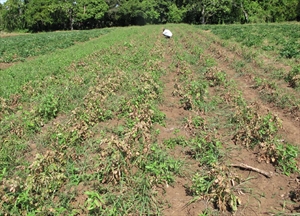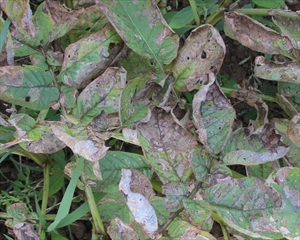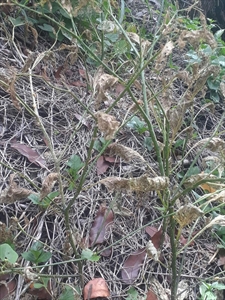Potato ladybird beetle, 28-spotted ladybird beetle, eggplant ladybird beetle (see Fact Sheet no. 58), Philippine ladybeetle.
Pacific Pests, Pathogens, Weeds & Pesticides - Online edition
Pacific Pests, Pathogens, Weeds & Pesticides
Potato 28-spot ladybird beetle (255)
Epilachna species. Epilachna vigintioctopunctata; previously, Henosepilachna vigintioctopunctata.
Asia, South America (Brazil), Oceania. The ladybird beetle is recorded from Australia, Fiji, French Polynesia, New Caledonia, Niue, Samoa, Solomon Islands, Tonga, and Vanuatu. On potato, it is recorded from Fiji and Northern Mariana Islands, and is probably present elsewhere.
Potato, and many other members of the Solanaceae family, weeds as well as crops.
The adults are like typical ladybird beetles with wing cases of dull orange and black spots (Photo1); however, close inspection shows that the upper surface is covered in short downy hairs. This distinguishes plant-feeding ladybird beetles from their beneficial bug-feeding relatives.
Adults and larvae strip the surface layers from both sides of the leaves (Photos 2-6). The damage causes loss of water, and the leaves dry, curl and die.
The oval yellow eggs (1 mm by 0.4 mm) are laid upright in batches of 10-20 on the underside of a leaf. They hatch in about 4 days. The pale yellow-whitish larvae have long, dark-tipped branched spines on their backs (Photos 6&7); they grow to 6 mm through three moults in the next 18 days, before attaching themselves to the undersides of the leaves and developing into pupae (Photo 8). This stage lasts another 4 days.
The adults fall to the ground when disturbed, pretending to be dead. They also produce a yellow fluid that wards off predators. Spread occurs when the adults take to the wing.
A serious pest of potato that destroys the leaves and kills the plants. Infestations in Fiji appear to be particularly damaging, and can result in total crop failure. An unidentified leafminer also occurs on the damaged leaves.
Look for the distinctive grazing on one side of the leaf, often leaving the surface of the other side intact. Look for the larvae, mostly on the underside, and the adults on the top of leaves, but always check that the beetles are leaf eating, i.e., they are feeding on the leaf, and are not beneficial species feeding, for instance, on aphids (green flies).
NATURAL ENEMIES
There have been no studies of the natural enemies of Epilachna species in Pacific island countries. Elsewhere, species of a parasitic wasp (Pediobius) have been introduced, achieving successful control of Epilachna. There are different species of the beetles, so identification needs to be done carefully. Also, care should be taken to ensure that any Pediobius introduced are specific to the pest species, and not likely to attack beneficial members of the family.
RESISTANT VARIETIES
None known.
CULTURAL CONTROL
Before planting:
- Do not plant potato next to crops that are known to be alternative hosts of the ladybird beetle, other members of the Solanaceae, including weeds, and also beans.
During growth
- Handpick the larvae, and perhaps the adults. If attempted, it should be done when the beetles are first seen in the crop.
- Remove weeds in the Solanaceae family from around the crop. However, it has been suggested these might act as trap crops, so some experimentation is needed.
After harvest:
- Collect crop debris after harvest and burn it.
CHEMICAL CONTROL
If chemical control is needed, do the following:
- Ash may be effective against potato ladybird beetles. Apply to the crop as soon as the pests are seen; do not wait until the population is high. (See Fact Sheet no. 56).
- Alternatively, add ½ cup of wood ash and ½ cup of lime in 4 L water; leave to stand for some hours; strain; test on a few infested plants first to make adjustment to the strength before large-scale spraying.
- Use plant-derived products, such as derris, pyrethrum or chilli (with the addition of soap). (See Fact Sheet no. 56).
- Alternatively, synthetic pyrethroids are likely to be effective, but will also kill natural enemies.
--------------------
Note, derris (Derris species) contains rotenone, an insecticide, often used as a fish poison; it should be used with caution. The commercial derris insecticide is made from Derris elliptica.
____________________
When using a pesticide, always wear protective clothing and follow the instructions on the product label, such as dosage, timing of application, and pre-harvest interval. Recommendations will vary with the crop and system of cultivation. Expert advice on the most appropriate pesticide to use should always be sought from local agricultural authorities.
AUTHORS Grahame Jackson & Mani Mua
Information from CABI (2012) Epilachna vigintioctopunctata (hadda beetle) Crop Protection Compendium. (https://www.cabi.org/cpc/datasheet/21518); and from Ladybird beetles in World. PotatoPRO. Based on Kroschel J, et al. (2020) Insect pests affecting potatoes in tropical, subtropical, and temperate regions. In: Campos H, Ortiz O (eds.), The Potato Crop. (https://www.potatopro.com/about/ladybird-beetles). Photo 1 Merle Shepard, Gerald R.Carner, and P.A.C Ooi, Insects and their Natural Enemies Associated with Vegetables and Soybean in Southeast Asia, Bugwood.org
Produced with support from the Australian Centre for International Agricultural Research under project PC/2010/090: Strengthening integrated crop management research in the Pacific Islands in support of sustainable intensification of high-value crop production, implemented by the University of Queensland and the Secretariat of the Pacific Community.











